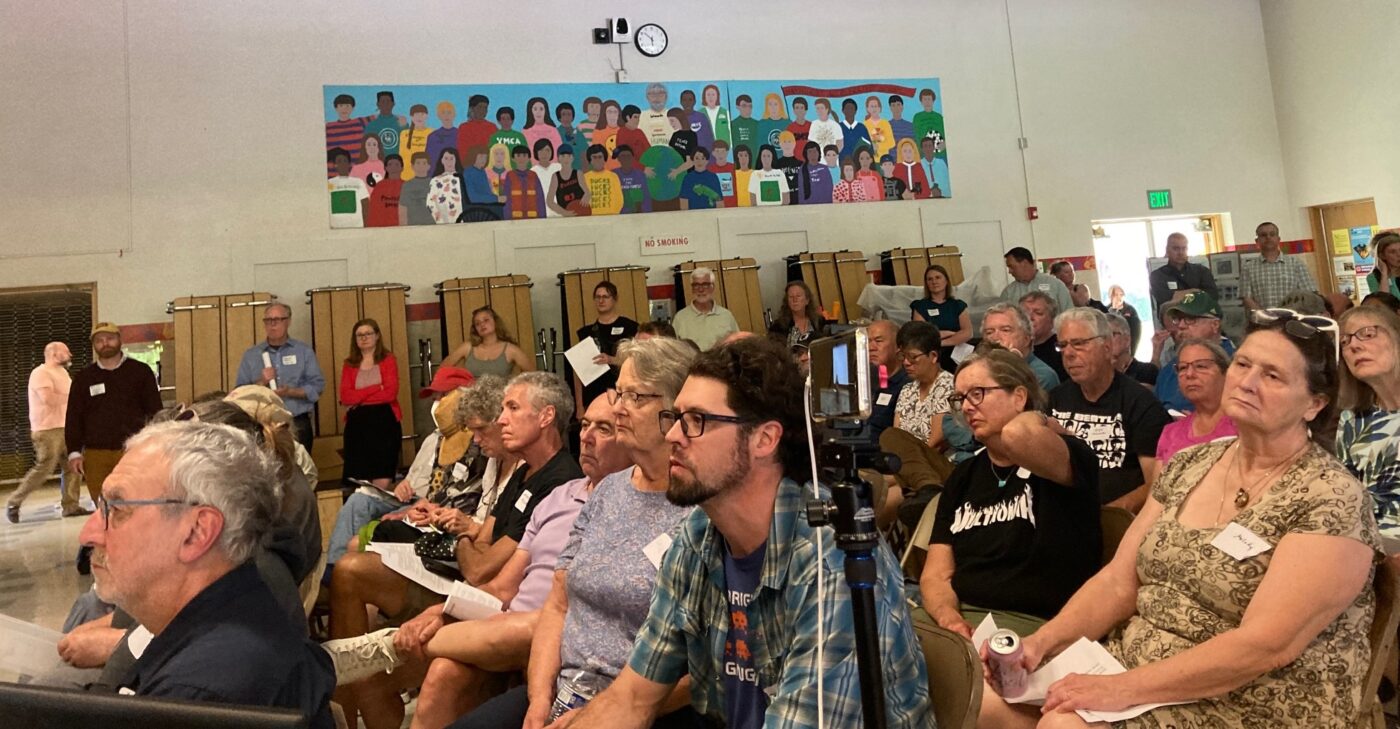
“Alpenrose is forcing the issue.”
– Event attendee
About a hundred and fifty people gathered at the Hayhurst Elementary School auditorium Monday night for a standing-room-only event billed as a “Community Conversation about Transportation in Southwest Portland.” Joining them were nearly 20 elected officials, staff, candidates for office, and representatives from government agencies.
The evening was organized by the Friends of Alpenrose (FoA), with help from Metro Councilor Duncan Hwang and State Representative Dacia Grayber in turning out other elected officials. FoA is a neighborhood organization which came together in response to plans to transform the 51-acre former Alpenrose Dairy site into a 263-unit subdivision.
While the impetus for the gathering was the Alpenrose development, the meeting covered the area’s broader transportation problems.
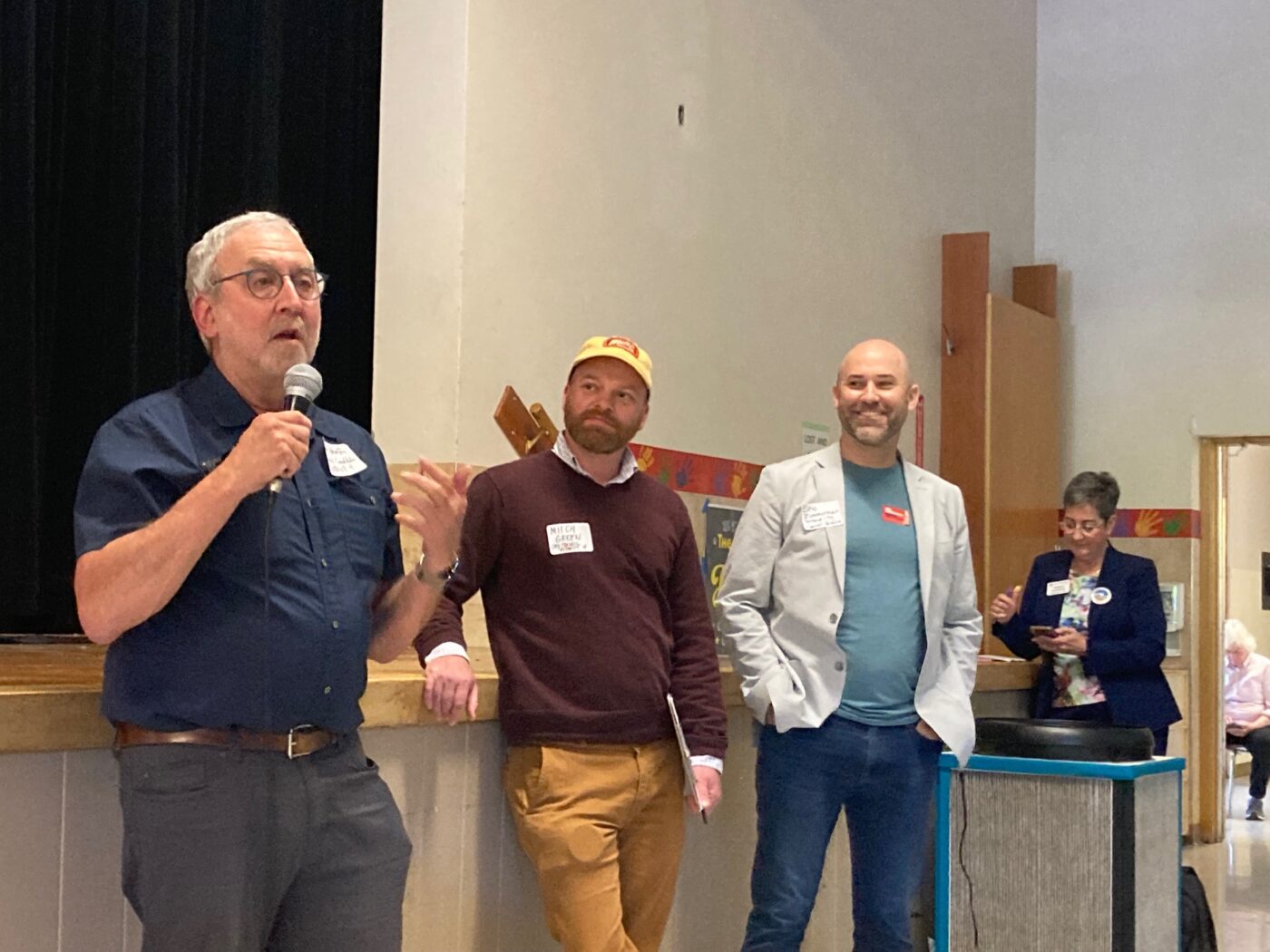
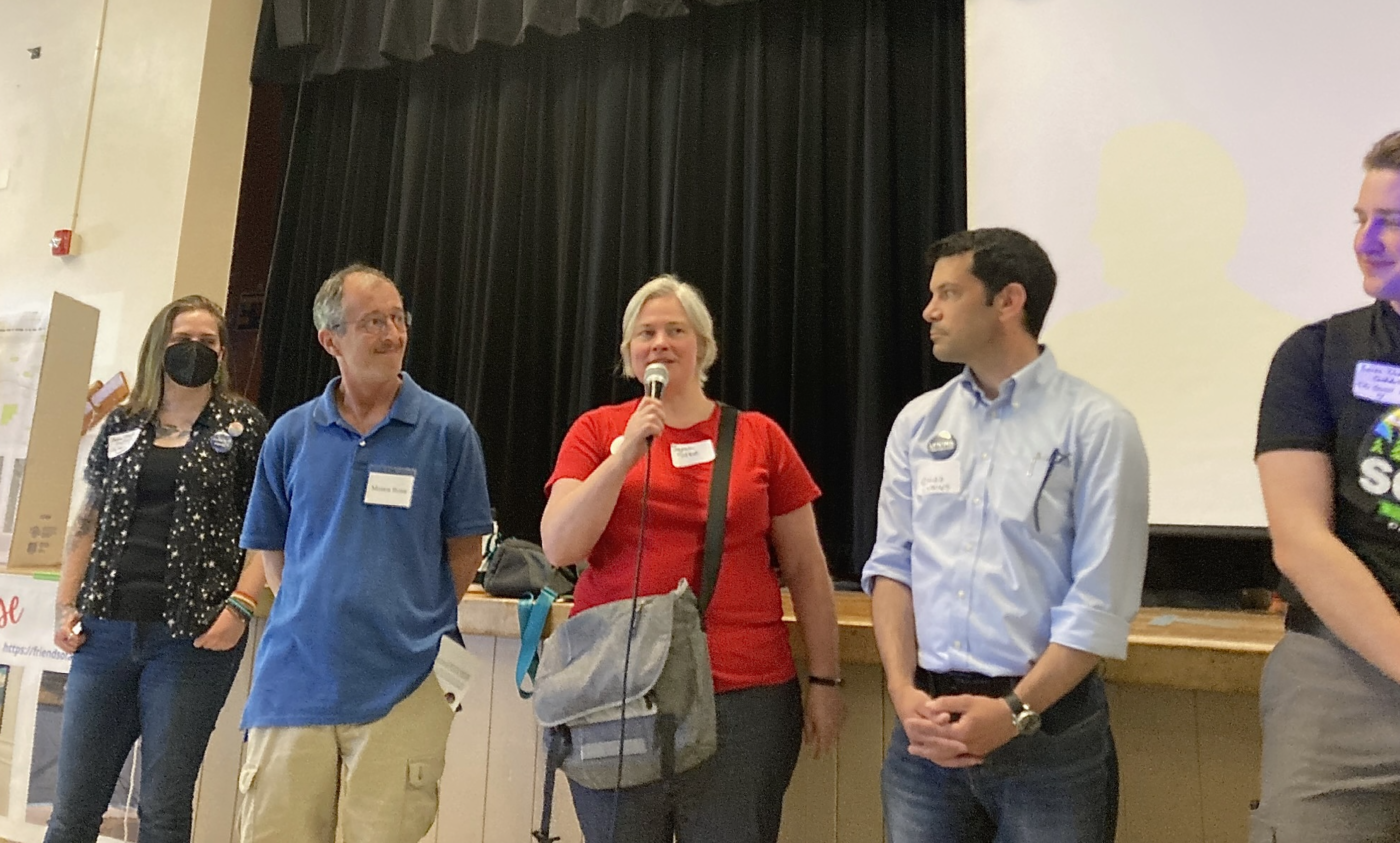
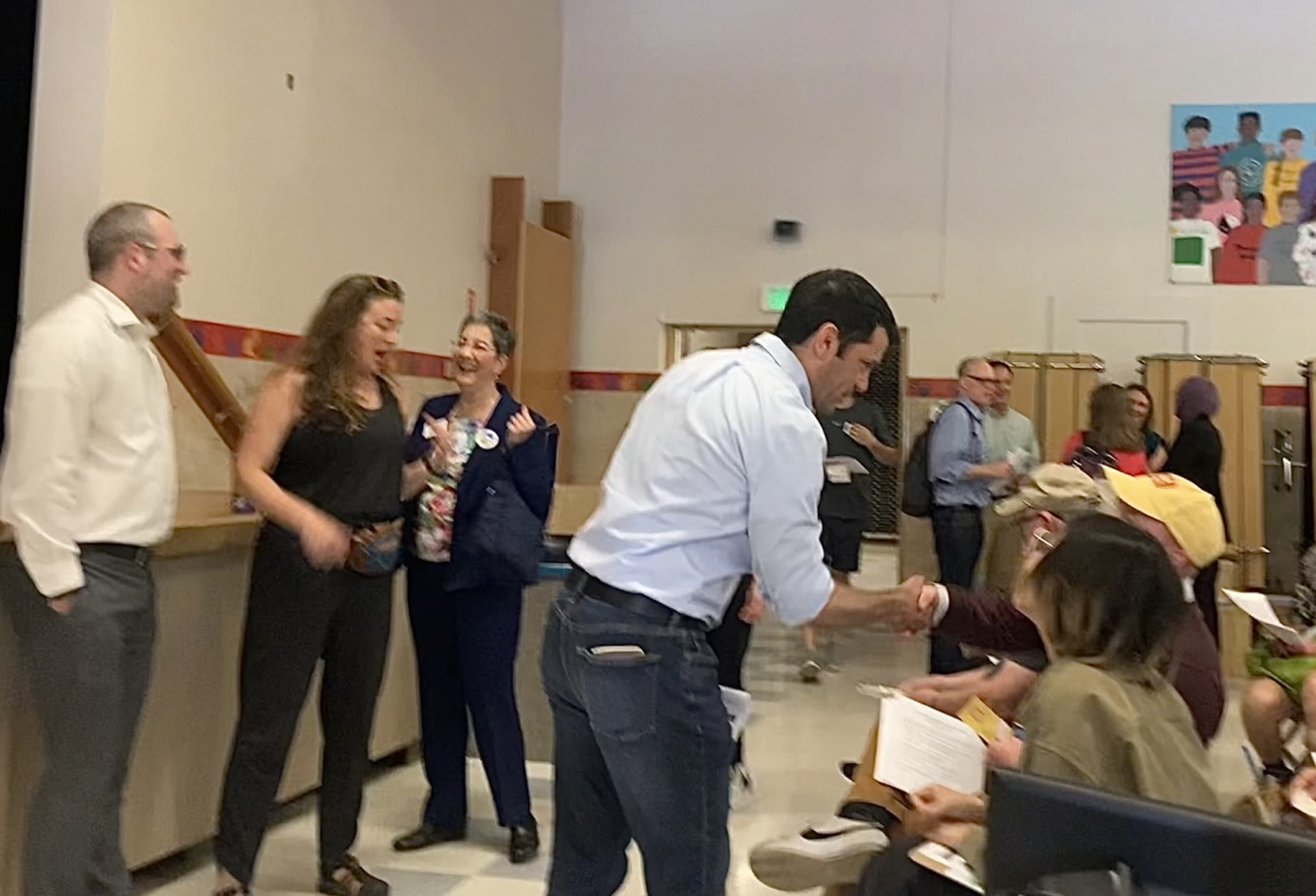
Marita Ingalsbe, a founder of FoA and President of the Hayhurst Neighborhood Association, began the meeting by introducing the public employees in attendance and pointing out how many different jurisdictions were affected by the development plans. Indeed, there were representatives from the cities of Portland and Beaverton, from Washington County and Metro, and from the Oregon Department of Transportation (ODOT) and Trimet. Not to mention that eight of the 18 candidates running to represent Portland City Council District 4 were in attendance.
Let’s just say a lot of hands were shaken and business cards exchanged.
One of the biggest talking points Monday night was the issue of jurisdictional challenges.

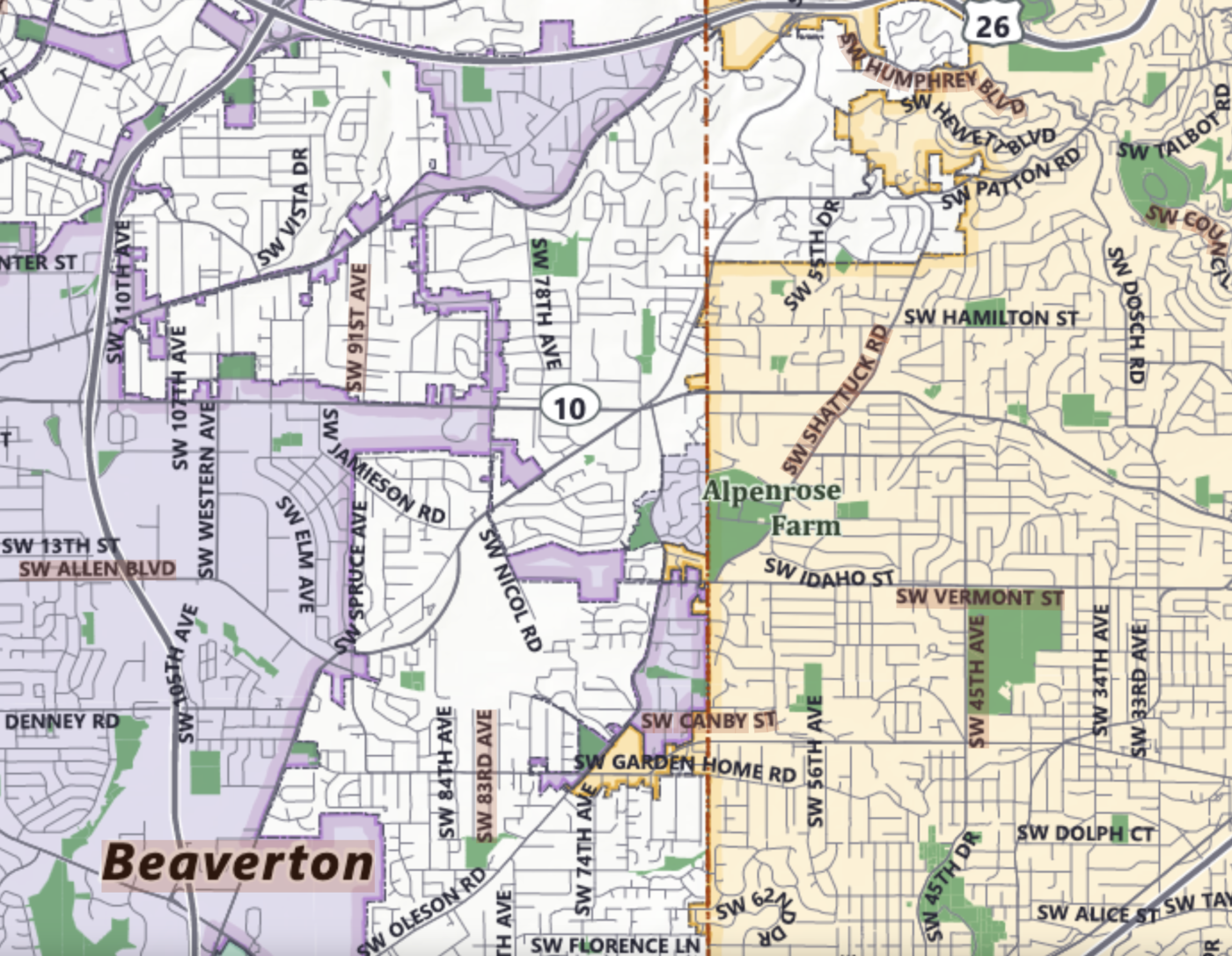
The patchwork of jurisdictions in play is one thing that complicates all transportation issues along the border between Multnomah and Washington counties — not just the Alpenrose development. This north-south border territory has a swath of some of the most poorly designed and dangerous roads you’ll find in the metro area. Those roads don’t have sidewalks or bike lanes, and their cross sections can change as you enter a new jurisdiction.
It’s not right, but it makes sense why that is so. As an advocate, it’s challenging enough to get something fixed when working with just a single jurisdiction, like the City of Portland. But when I was on my neighborhood association’s transportation committee, neighbors would regularly contact me about that speedway known as SW Scholls Ferry Rd, which runs through three jurisdictions: the City of Portland, and unincorporated Washington and Multnomah counties. Why can’t Scholls have a sidewalk, they’d ask. We need another turn lane! We need to get rid of the turn lane! If we narrowed the lanes there would be enough room for a sidewalk and a bike path! I heard it all.
Scholls Ferry is so dangerous for anyone not in a car that TriMet refuses to put bus stops on it. As a transportation volunteer, I never knew where to begin and, apparently, even folks receiving a paycheck don’t know what to do.
In general though, the Washington County side of border territory is mainly unincorporated, with small islands of City of Beaverton within it. The Multnomah County side is mostly City of Portland, which leads to the border territory’s second complication: Portland has neglected to provide basic infrastructure to this part of town for half a century. And no one has wanted to own the growing problem.
But, as one attendee told me, “Alpenrose is forcing the issue.”
Metro Councilor Duncan Hwang’s role
There is a saying in finance that goes like this: “If you owe the bank a million dollars you’ve got a problem. If you owe the bank $100 million dollars, the bank has a problem.” That doesn’t exactly fit this situation, but as I listened to several public sector employees tell the audience to “keep advocating,” I found myself thinking that the problem is bigger than something neighborhood volunteers should be responsible for solving. And that, yes, the neighbors have a problem, but so do all these different representatives and public sector employees. Alpenrose is a whale of a development which, when you consider that recent “missing middle” housing rules allow each eventual owner to add additional units to their property, severely strains the area’s already sub-par transportation system.
(Plus, I was recently in a meeting in which a veteran southwest bicycle advocate quipped “we all have bruises on our foreheads,” presumably from banging heads against the wall for so many decades.)
Hopefully, Metro Councilor Hwang, who played an outsized role in the meeting, and State Representative Dacia Grayber can champion this part of town and orchestrate a solution. Because this is a political problem.
As Marita Ingalsbe explained to me, “It makes sense for Metro as the regional transportation planner to take the lead.”
What about stormwater?
“It shouldn’t take 25 years to get a sidewalk.”
– Mitch Green, city council candidate
In a meeting which covered many, many issues — from sidewalks, to bus service cuts, to transportation plan prioritizations, to matching federal grants, to the state’s upcoming transportation package — one issue I didn’t hear mentioned was the area’s lack of stormwater facilities. In a lot of ways, that’s the problem which unites them all.
Currently southwest Portland does not have a formal stormwater system, instead its run-off drains to streams. Stormwater from impermeable surfaces like sidewalks is not allowed to go, per federal environmental regulation, directly into creeks and streams without treatment to slow it down, cool it off, and filter out pollutants. In many cases, developers cannot be required to provide that treatment for public works like sidewalks, and in recent years public works development review has stopped requiring sidewalks on the frontage of many new developments, thus not capturing for the public good the frontage improvements which are required.
It might make transportation seem more manageable to address it street by street, but, like whack-a-mole, the same inability to put a sidewalk in one place just repeats itself in a different location.
Or, as district four candidate Mitch Green said, “It shouldn’t take 25 years to get a sidewalk.”
My takeaway
This was a remarkable event. I’m impressed that so many residents showed up to a meeting about transportation, and was really blown away to have this collection of elected officials in a room together addressing the topic. That alone felt like an accomplishment.
But to have eight city council candidates already versed in transportation issues, months before the election, and before even holding office, was all I needed to see to believe that our new form of elections, with ranked choice voting and multi-member districts, is working. The level of engagement is the highest I’ve ever seen it, and these candidates are working their rear-ends off.
I don’t have the answers to southwest’s transportation problems. But I know that cutting bus service, and not providing safe networks for walking and biking just makes the area more dependent on the automobile. I’m hopeful that people who know more about this than I do will soon start working together to make the southwest the best it can be.



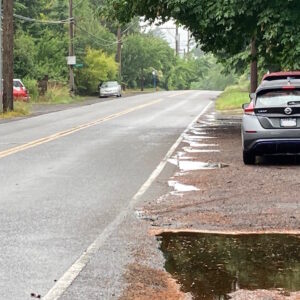


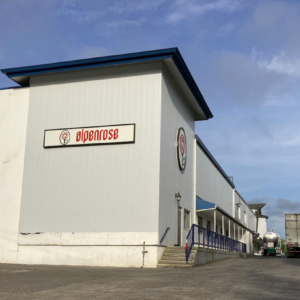
Thanks for reading.
BikePortland has served this community with independent community journalism since 2005. We rely on subscriptions from readers like you to survive. Your financial support is vital in keeping this valuable resource alive and well.
Please subscribe today to strengthen and expand our work.
Is it just me, or has Metro gotten less involved over the years? I swear they’re more deferential to their constituent cities than they used to be. This isn’t necessarily bad, but it seems to be causing coordination issues, which kind of negates the whole point of having a regional governing authority.
Frankly, this whole discussion reminds me of the issues of management and services in the unincorporated areas between Portland and Gresham before those areas were annexed back in the 80s. The fundamental problem of this area appears to be the complexity of having so many unincorporated neighborhoods on the Washington County side that have historically resisted annexation into Beaverton, despite the fact that they’re at once urbanized, reliant on Beaverton-managed roads, and totally surrounded enclaves. It adds a huge amount of bureaucratic complexity, and it’s not surprising that the city of Beaverton is less responsive to solving issues of non-residents there that don’t vote or pay taxes to them, nor is it surprising that the County has been less than adequate serving them as well. You just can’t have county-level taxes with city-level services.
It definitely feels like a microcosm of a broader public issue: people wanting public services without being willing to pay for them. (Or, failing that, getting public services that are underfunded or poorly run, saying “government can’t do anything”, and then trying to opt out of being part of the public…which none of us can really do)
The big-picture solution to this is to make these areas join Beaverton or Portland, and then a bigger pool of resources can be directed to fix these local issues.
As an aside, I just want to voice the double standard of “road runoff fine, sidewalk runoff not okay” implicit in the stormwater drainage issue. This country REALLY wants everyone in a car.
Except this site is most certainly inside the City of Portland.
The rep from PBOT, Ms. Castro, said “we’re broke; expect nothing from us.” The west side politicians all said ‘gee, how about that intersection, huh!”
So here’s what will happen: if it doesn’t hit some obstacle like stormwater, the Alpenrose development will have a nice MUP along a stretch of Shattuck frontage that conects to nothing. There will be a stop sign at the emtrance – very remotely a light, but a 4-way stop seems likely. ODOT and WashCo will attempt to re-time the lights at BHH/Scholl’s.
And that’s it. Decisions have been made. The best thing for this outcome NOT to happen is for the developer to go away, and a new one try again in a year or two, with a different council setup and some time for outrage to build – AND for the City Auditor’s new report on Vision Zero “results” to get done!
All the officials in the room made it quite clear that they had no money to do anything in SW – Castro and a TriMet rep both basically said “what part of ‘budget shortfall’ don’t you people get?” – and some have little to no interest in looking for some due to equity issues. That nasty intersection can’t be fixed without eminent domain, and ONE jurisdiction willing to take the lead (and bulk of expense).
As far as I can tell, it ISN’T. We definitely need to elect candidates who are outraged that the status quo was allowed to happen, but it will be too late.
All these bureaus are welcome to prove me wrong. They can each throw the first shovelful of dirt on me at the groundbreaking if they do.
If nothing else, this meeting and the comments point out that there some things that need to be addressed on a state and local level to have decent better land use planning and more functional government.
First, the intersection that is of such great concern, the BH/Scholls/Oleson intersection IS in a single jurisdiction, Washington County. ( it’s just to the right of the 10 in the circle on the map at the top of the article) But, two of those roads are roads under state control, so at least two jurisdictions need to get involved. State responsibility for surface streets in urban areas never works well.
Plans were made in the 1990s to rebuild this intersection, but after passage of measures 5 and 50, the funding disappeared and now would likely require something like a local option levy for the county to take it on.
Unincorporated areas ? 40% of the population of WaCo lives in unincorporated areas, so even if it were still legal for cities to annex land without voter approval, which city gets the land? Beaverton seems a reasonable choice but what about Tigard? They’re next to a lot of the islands. And to be fair to WaCo, on the map, you can see a chunk of unincorporated land in Multnomah County, in a location that depends on the City of Portland for access in and out of that island.
Thank you for commenting, Bob. I’m mostly ignorant of Wa Co politics, it’s just too much for me to follow. But I don’t want to let the City of Portland, and its politics, off the hook on any of this. Portland underfunds the southwest, and our streets come out low on city prioritizations — by design. The person Monday night who spoke most directly about this was District 4 candidate Bob Weinstein.
I’m looking forward to having district representation, and hope that that at least one of our representatives will push back when halo-polishing narratives about the undeserving, rich southwest get trotted out. Look at the woman in the right foreground of my post’s top photo. Halo-polishers are polishing their halos on her. She is the person without a sidewalk.
(Also, In my mind at least, I don’t consider the term “jurisdiction” to be limited to just counties and cities. ODOT has jurisdiction over some things, TriMet is it’s own decision-maker.)
Thank you for highlighting my comments and concern about Southwest being underfunded- transportation infrastructure, stormwater, and more.
Bob Weinstein
City Council Candidate, District 4
PBOT seems to have been in charge of transpo issues on a number of projects in unincorporated Multco area out there.
A business owner who sought to buy some of the Safeway property said he backed out when told the City of Portland was going to require several milllion dollars upon sale to rejigger parts of the intersection; apparently a part of the structure is in unincorporated/WashCo, and the other is in Portland/Washington. Grains of salt available for purchase on that anecdote, of course.
I think the issue for the jurisdictions is that even if WashCo decides to bite the bullet and eminent domain a few lots and get going, the other jurisdictions might not have the money to partner with them. Be kinda comical if 3 of the roads didn’t connect any more.
I can imagine the scene in Beaverton where several agencies ask their neighbor “So – gonna dump a huge problem in our lap. What ya gonna do about it?” and Portland replies “Brother, can you spare a dime?”
We hear a lot about equity and inclusion when anything comes up about spending money in SW Portland.
Let’s tally up the total picture of SW vs the total City of Portland:
— Equity and Inclusion: SW is currently 14% non white. I believe we need to treat this 14% and the other 86% equitably, not pick favorites to skew funding in a major way. How will our SW community become more diverse if we do not invest in the facilities the more diverse community needs to participate in our community. While our average income is higher than the Portland average, many of our SW residents are just as poor as poor people living elsewhere in the city. They deserve the same services as those living elsewhere.
— Taxes: SW property assessments relative to other parts of the city tend to be much higher due to the valuation base set in 1995 and cemented in place with a state constitution amendment.
— Policing: Much fewer police per capital patrol SW Portland than in other parts of the city.
— Sewers and water: SW residents have been paying off the $1.2 billion (if my memory is correct) cost of the Big Pipe for decades. The Big Pipe stores surges of stormwater to keep the Willamette cleaner except for very heavy rain storms. Very little, if any, of the Big Pipe serves SW Portland.
— TriMet: Many SW bus route have been decreasing service for years. With the last service changes enacted by TriMet they have increased services on arterials where housing is denser. At the same time TriMet has decreased service to many homes. We have been unable to get TriMet to tell us how many SW residents do not have access to regular bus service within 1/4 mile walking distance. It is fair to say the bus service trend in SW Portland it to make it a more car dependent community — without even minimal safe family friendly bicycle facilities to give them an alternative way to reach work and key services. With the advent of electric bicycles our hilly environment is less of an impediment.
— Transportation: Compare the percentage of our SW streets lacking sidewalks (75%) relative to any other part of the city. Many miles of our arterials lack sidewalks. Pedestrians are treated by PBOT as third class citizens behind motor vehicles and bicycles. For example, PBOT has installed miles of cheap flimsy wands along some of our busy SW arterials and then marked them with bike symbols. Where do pedestrians have to walk? In the bike lanes, where some bikers are very rude. Efforts to get these routes marked with both Pedestrian and Bicycle symbols have gone nowhere. The only family-friendly, City Council-approved bike facility serving greater SW and Washington County — The Red Electric multi-modal trail — has gone largely unfunded.
— Street sweeping: As I understand the PBOT rules, they only sweep streets with curbs. Since 75% of our streets do not have sidewalks, it is reasonable to assume 75% of our streets do not get street sweeping.
There are likely more inequities in city services biased against SW Portland. I leave them to others to articulate.
Great comments, Don. Thanks.
Posted on another website today, this quote from an old Bloomberg article:
https://www.bloomberg.com/news/features/2018-08-31/why-is-american-mass-transit-so-bad-it-s-a-long-story
Me: Since I can’t safely walk to that arterial, I guess I’ll drive.
Trimet: See, SWers prefer to drive!!
Great article, Lisa. Thank you.
I learned a lot at the meeting.
Bob Weinstein
City Council Candidate, District 4
No smiling faces in the audience is somewhat tellling.
What I think this discussion seems to inconveniently lack is that the neighborhood advocates who are opposed to this development seem to have amnesia that Metro tried designating this area as a Town Center 25 years ago, but neighbors came out in force to oppose it. It was a really big deal at the time, but it would have solved most of the transportation woes that are being brought up now. So if you’re looking for a reason why officials are responding this way, that could be part of your answer.
Is that the fault of the people who live there, NOW, who accept the change but want the impact addressed? Or is that the fault of institutions and staff bearing grudges?
“I can’t work with a Democrat; they supported slavery in 1860!”
I also seem to recall that the big SW plans were rejected in late 90s because Portland promised that ped/bike/stormwater infrastructure would be built rigiiiigggghhhht after all that dense development happened. They pinky-swore!
Now, of course, the city won’t even bother to pinky-swear about doing it someday.
No, it’s that they’re tired of going to war and doing the thankless work that ultimately gets shit on no matter the outcome.
They can quit their dispiriting job and clear their desks for those who wish to do the work they are paid for.
It is not their “jobs” to spend the next 3-5 years listening to hallow concerns from a minority opposition, one half opposed to any change, with their story steeped in “history” and “character” (illegal under Oregon law to block housing development based on this) and the other half uneducated in how municipal finance and infrastructure actually gets funded and built. Regardless of the merits (or lack thereof) from the proposal, people just love to complain, especially upper income white people, whenever housing comes to their neighborhood.